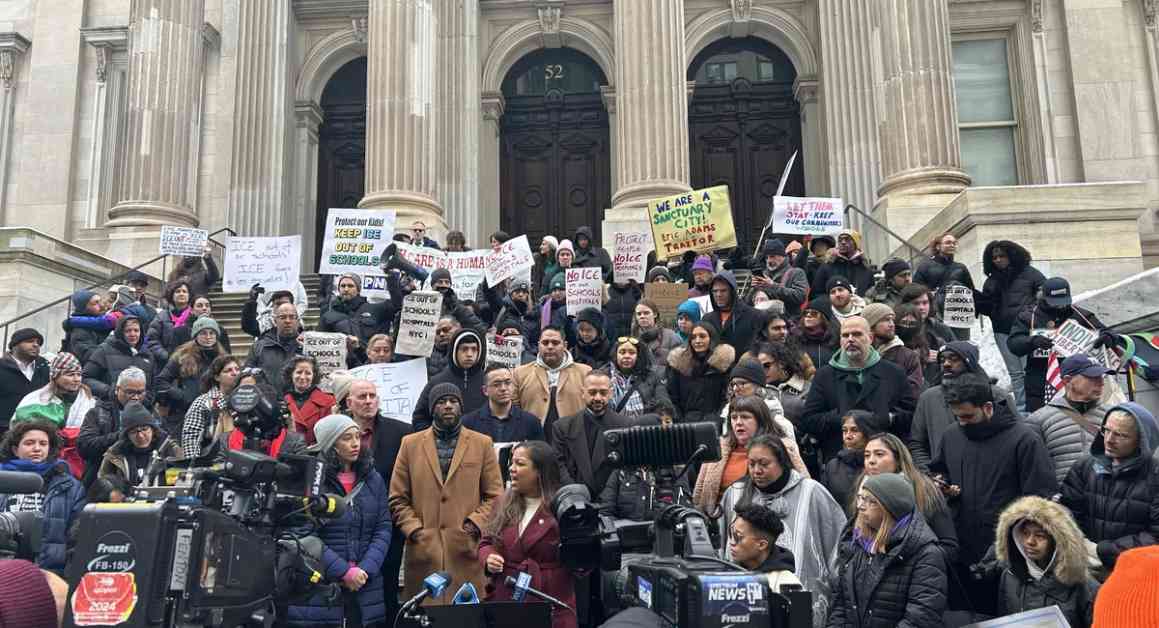New York City Mayor Eric Adams has recently faced criticism for his new guidance to shelter workers regarding cooperation with visiting federal immigration officers if they “reasonably feel threatened.” The memo, sent by City Hall on Jan. 13, instructs staff at nonprofit-run migrant shelters and other city-related facilities to comply with federal immigration officers if they perceive a threat to their safety or the safety of those around them. This directive has sparked backlash from immigration advocates and lawmakers, who argue that it undermines the city’s sanctuary protections.
The new guidance represents a shift from previous instructions that emphasized protecting city workers and resources from being used to further federal immigration enforcement. The controversial move has raised concerns about the potential impact on immigrant communities and the safety of individuals seeking shelter in the city.
Advocates and Lawmakers Respond
At a rally protesting the policy change, Ana Maria Archila, the co-director of the New York Working Families Party, expressed concerns about the implications of Mayor Adams’ directive. She warned that the guidance could embolden federal officers to adopt a more aggressive approach, potentially putting vulnerable populations at risk.
Department of Education Chancellor Melissa Aviles-Ramos also weighed in on the issue, reassuring parents that existing policies remain unchanged. She reaffirmed the city’s commitment to protecting all children, regardless of their immigration status, and emphasized that non-local law enforcement officers are not permitted in school buildings without a judicial warrant or exigent circumstances.
City Hall spokesperson Kayla Mamelak clarified that the intent behind the new guidance was to prioritize the safety of both employees and individuals under their care. She stressed that the city was not mandating automatic cooperation with federal law enforcement but rather providing guidelines on how to handle ICE visits to shelters and other city sites. Mamelak urged city workers not to obstruct law enforcement actions but to follow established protocols when interacting with federal officers.
Criticism and Response
Critics of Mayor Adams’ stance accused him of aligning with former President Donald Trump and undermining New York City’s sanctuary policies. Murad Awawdeh, president and CEO of the New York Immigration Coalition Action, condemned the mayor for disregarding local laws and enabling city employees to circumvent sanctuary protections when it suited them. The accusations of Adams “cozying up” to Trump and potentially facing a pardon amid ongoing investigations have further fueled the controversy surrounding the new guidance.
In response to the backlash, Mayor Adams appeared on WABC’s “Tiempo” to address concerns about potential ICE raids and reassure immigrant communities. He emphasized the importance of not allowing rumors to instill fear or disrupt daily life, urging individuals to continue engaging in essential activities such as attending school, seeking medical care, and reporting crimes. Adams underscored the distinction between federal officers pursuing serious criminals and the need for city employees to respect the authority of immigration officials in such cases.
As the debate over Mayor Adams’ sanctuary policy stance continues, it remains a contentious issue that has divided opinions within the city. The conflicting perspectives on immigration enforcement, safety protocols, and the role of local government underscore the complex challenges faced by New York City officials in balancing law enforcement priorities with the protection of vulnerable populations.
This evolving story reflects the ongoing dialogue between advocates, lawmakers, and city officials on how best to navigate the intersection of immigration policy, law enforcement, and community safety. The implications of Mayor Adams’ guidance extend beyond shelter workers to encompass broader questions about the role of sanctuary policies in safeguarding the rights and well-being of all individuals residing in New York City.
By delving into the nuances of this contentious issue, we gain a deeper understanding of the complexities involved in shaping immigration policies at the local level and the impact of such decisions on the communities they seek to protect. As the debate unfolds, it is essential to consider the perspectives of all stakeholders and strive for solutions that uphold the values of inclusivity, safety, and justice for all residents of New York City.












